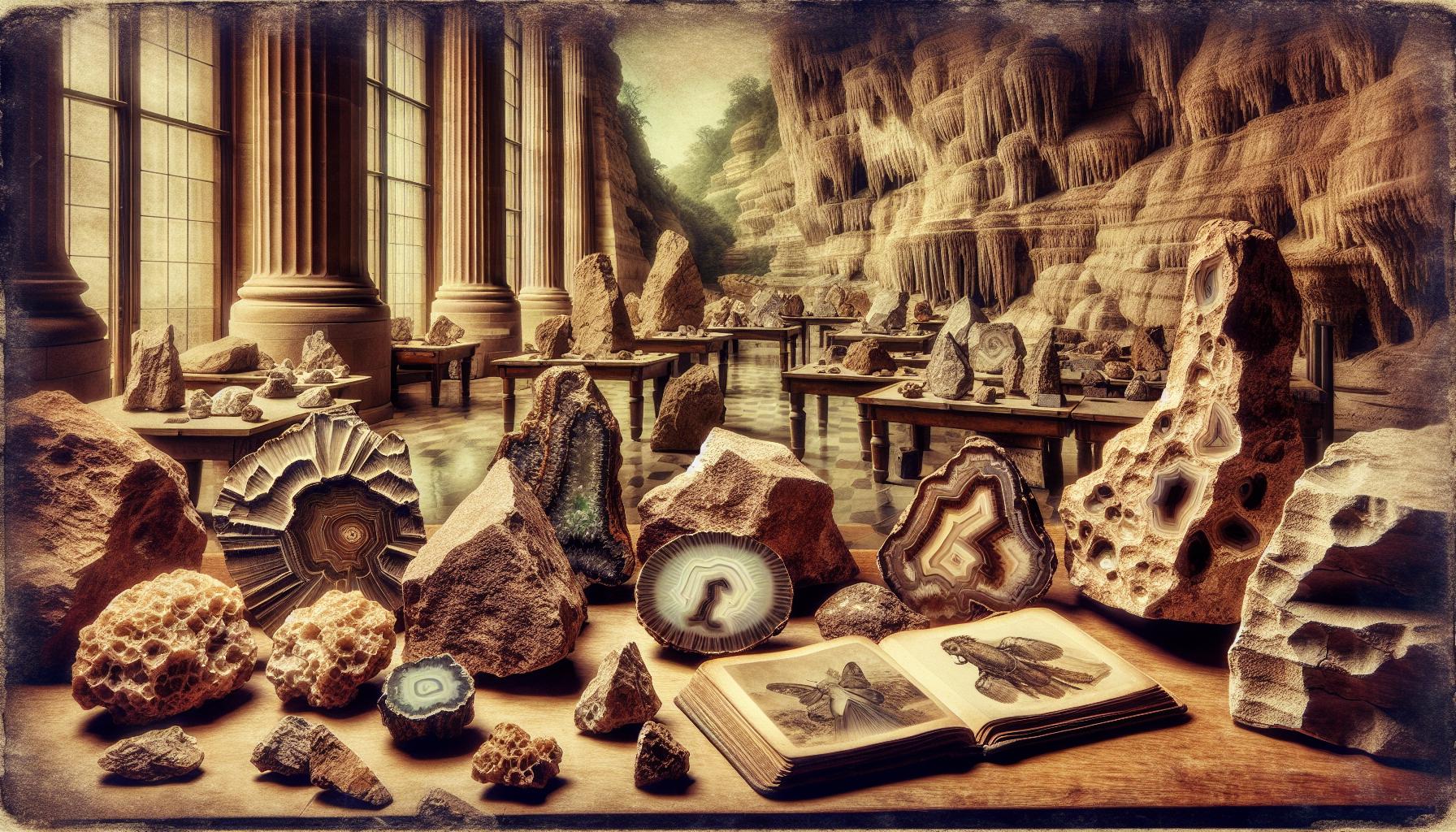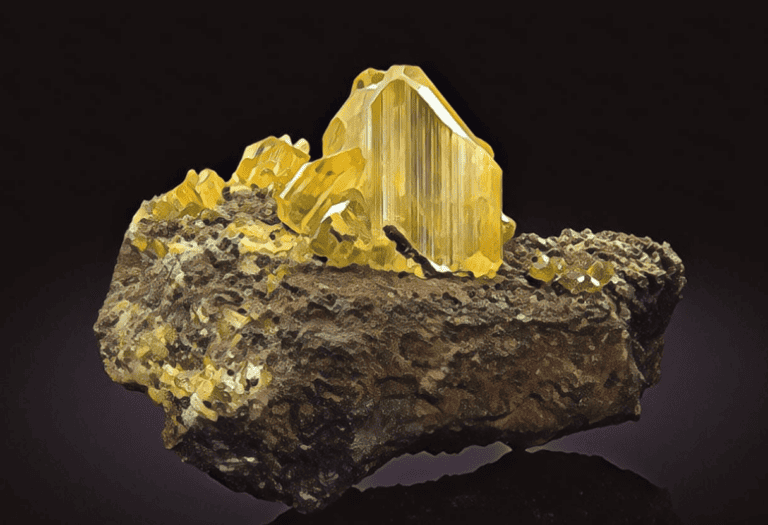Missouri, the Show-Me State, is a hidden gem for rockhounds seeking treasure beneath its soil.
You’re in for a treat with a landscape dotted with mines and natural areas rich in geological wonders.
Whether you’re a seasoned collector or just starting out, Missouri’s diverse regions offer a variety of minerals and crystals.
From the drusy quartz of the Ozarks to galena and calcite treasures, you’re sure to find something spectacular.
Missouri is a prime destination for rockhounding, offering a wealth of minerals like drusy quartz, galena, and calcite across various regions including Washington County, the Ozarks, and Bonne Terre. Remember to seek access permission and follow local regulations for a successful and respectful rockhounding experience.
Get our FREE United States Rockhounding Map HERE

Missouri Rockhounding Locations
Missouri, with its abundant geological diversity, offers a wide array of locations for rockhounds to explore. Whether you’re seeking drusy quartz, galena, or calcite, there’s a spot that caters to your interests.
One of the most renowned spots is Washington County, home to the Old Mines Area. Here, rockhounds often uncover impressive specimens of galena, the natural mineral form of lead sulfide and Missouri’s state mineral. Another hotspot is the Viburnum Trend, also known as the New Lead Belt, where significant deposits of galena can be found.
For those gripped by the allure of sparkling drusy quartz, the drusy quartz fields of the Ozark region are a can’t-miss destination. These silvery crystals are dispersed across the rocky landscape, hidden treasures waiting to be discovered. The presence of drusy quartz has made places like the Lake of the Ozarks a popular site for enthusiasts and casual collectors alike.
If it’s calcite you’re after, the Bonne Terre region should be on your list. With its extensive mining history, Bonne Terre is ripe for uncovering various minerals, including striking calcite formations. As you plan your visit, keep in mind that many of these locales are on private property or protected land, so always seek permission and adhere to local regulations.
| Region | Notable Minerals |
|---|---|
| Washington County | Galena |
| Viburnum Trend | Galena, Sphalerite, Calcite |
| Ozark Region | Drusy Quartz |
| Bonne Terre | Calcite |
When preparing for your rockhounding adventure in Missouri, it’s important to equip yourself with the right tools—a sturdy hammer, chisels, and protective eyewear are essentials. Don’t forget to also bring along a field guide to help identify your finds. With each swing of the hammer, you’re not only uncovering Earth’s natural wonders but also connecting with the state’s rich mining heritage.
Remember, the key to a successful rockhounding trip is respect—respect for the land, its resources, and its history. By following the code of ethics for rockhounding, which includes responsible collecting, minimal disturbance, and consideration of others, you’ll ensure that these sites remain available for future generations of mineral enthusiasts to enjoy.
What Gemstones are Found in Missouri?

Missouri’s landscape is a treasure chest for gemstone enthusiasts. As you explore the state’s varied geology, you’ll find an incredible array of gemstones, each with its unique appeal and history.
Discover the Riches of Missouri’s Earth
- Mozarkite is Missouri’s official state stone. This colorful chert variant is coveted by gem hunters for its beautiful swirls of colors, predominantly in shades of red, pink, and brown.
- Barite, often found in the Washington County area, is an important mineral for the state. You’ll recognize it by its crystal formations and range of colors, including white, yellow, and blue.
- Rich blue vivianite and striking galena crystals can also be found.
Boasting a Spectrum of Stunning Colors
In the plethora of Missouri gemstones, drusy quartz stands out with its sparkling surface peppered with fine crystals. Whether set in jewelry or appreciated in its natural state, drusy quartz has become synonymous with the state’s geode treasures.
Mining in Missouri can also lead to delightful surprises, such as the discovery of:
- Amethyst with its vibrant purples
- The yellow-green hues of peridot
- The sunset colors of agates
Unearthing Missouri’s Hidden Gems
Missouri isn’t just about the rocks and minerals, but also the stories that every find tells. Amethyst, for instance, can be linked to ancient legends and holds a revered place in many cultures, adding layers of meaning to your finds.
Knowing where to look is crucial. Graves Mountain and the Sweetwater Mine have made names for themselves with collectors. They often yield high-quality specimens beloved by both seasoned rockhounds and beginners alike.
Always remember to respect the land you’re exploring. The true joy in rockhounding comes from the sustainable collection, appreciation of nature’s artistry, and the sense of adventure as you delve into the earth’s hidden trove.
Whether you’re a mineral enthusiast or a casual collector, Missouri offers a wealth of gemstones waiting to be unearthed. Equip yourself with knowledge, appropriate tools, and a respectful approach to the environment, and you’re set to uncover the state’s geological marvels.
What Sedimentary Rocks You Can Find in Missouri?

In Missouri, the hunt for sedimentary rocks can be as rewarding as it is fascinating. Sandstone and limestone are the state’s most notable sedimentary offerings. Sandstone is prevalent and can be spotted in shades of red, yellow, or tan, each color signifying a different composition. Limestone, often embedded with marine fossils, tells a story of ancient seas that once covered the land.
Wander through the Ozark Plateau and you’ll stumble upon Dolomite, a close relative to limestone. It’s easily distinguishable by its pearly luster. Both limestone and dolomite form the bedrock beneath much of the state, creating a paradise for rockhounders with an appreciation for sedimentary geology.
Missouri is also famous for its geodes, which, while not entirely sedimentary in origin, often have a sedimentary shell. These geological marvels are particularly concentrated around the Warsaw Formation. It’s key to remember that geodes can appear unassuming from the outside, yet house a treasure trove of minerals like quartz and calcite within.
Key Locations for Sedimentary Rockhounding
Certain areas are hotspots for sedimentary rock enthusiasts:
- Grand River: Ideal for collecting different types of chert.
- Crowley’s Ridge: A go-to spot for those seeking unique sandstone specimens.
- Klondike Park: Famous for its geodes and quartz-heavy sandstone.
What Metamorphic Rocks are found in Missouri?
Missouri’s geological tapestry isn’t limited to just sedimentary rocks; metamorphic rocks also make a notable appearance. While less common, these rocks are a massive draw for enthusiasts looking to expand their collection. Metamorphic rocks form from pre-existing rocks that have been transformed by intense heat and pressure deep within the Earth’s crust, resulting in new mineral configurations and textures.
In the Show-Me State, novaculite is a type of metamorphic rock that stands out. Primarily comprising microcrystalline quartz, novaculite is known for its use in creating sharp edges, making it a historical tool for manufacturing cutting tools and whetstones. If you’re after this unique rock, head to the St. Francois Mountains, a region famed for its geological diversity.
Another fascinating find is quartzite, a hard and dense rock transformed from its original state of sandstone. Quartzite’s palette ranges from pinks to deep reds, presenting a vivid addition to any rockhound’s collection. Look for quartzite in the Proterozoic rocks of the Eastern Ozarks, where its vibrant colors light up the terrain.
Don’t overlook Missouri’s variety of slate, a fine-grained metamorphic rock with a reputation for being both durable and versatile. Often associated with old-school chalkboards, slate can also be found in shades of green, black, and gray. It’s primarily found in the Central Eastern Ozarks; however, it’s much less prevalent than the area’s signature sandstone and limestone.
Visiting the Precambrian exposures in the Ozark Highlands may reward you with gnarled and folded rocks that speak volumes of the Earth’s dynamic processes. These areas reveal the high-grade metamorphic rocks that only surface rarely but will significantly bolster your geological knowledge and collection.
Here’s what you can generally expect to find:
- Novaculite: St. Francois Mountains
- Quartzite: Eastern Ozarks
- Slate: Central Eastern Ozarks
To unearth these ancient and transformed treasures, don your best rockhound gear and scout the indicated regions with a keen eye. Missouri’s metamorphic rocks, just like its sedimentary counterparts, capture the profound story of the Earth, waiting to be discovered and appreciated.
What Igneous Rocks can You Find in Missouri?
As you delve into the rich geological landscape of Missouri, you’ll find that igneous rocks add to the state’s diverse mineral profile. Known for their crystalline beauty and formed from cooled magma, these rocks present a thrilling find for rockhounds. Granite and rhyolite are two of the most prominent igneous rocks available in Missouri, and each offers a unique rockhounding experience.
Granite, a widely sought-after igneous rock, is found primarily in the St. Francois Mountains of southeastern Missouri. This area, heralded for its vast array of mineral deposits, boasts large granite outcrops. You’ll marvel at the coarse texture and the interlocking crystals that make granite a favorite among collectors. It often features eye-catching specks of quartz, feldspar, and mica.
Moving on, rhyolite—another fascinating igneous rock—is prevalent in the same region. Extracting rhyolite can be an adventurous endeavor as it usually requires careful exploration of the area’s old volcanic deposits. Its fine-grained texture and often vibrant colors make it easily distinguishable from other rocks.
When rockhounding for igneous rocks in Missouri, check out these key locations:
- Elephant Rocks State Park
- Johnson’s Shut-ins State Park
- Amidon Memorial Conservation Area
At Elephant Rocks State Park, for instance, you’ll encounter granite boulders as large as houses, providing an awe-inspiring spectacle. These ancient behemoths offer a direct link to Missouri’s volcanic past.
For a safe and rewarding rockhounding adventure, it’s essential to be aware of the legalities. Always obtain permission to collect on private lands and adhere to the regulations of public sites. With the right preparation, you’re set to uncover the fiery origins of Missouri through its igneous rock formations.
Panning for Gold in Missouri
Panning for gold might seem like a relic of the past, but in Missouri, it’s a hobby that still shines. The state isn’t known for commercial gold mining, but recreational prospectors can still find small amounts of gold. Streams and rivers in the Missouri Ozarks have surprise traces of this elusive mineral.
Meramec River, and its tributaries, including the Bourbeuse and Big rivers, are popular spots for panning. You might also want to explore areas like Missouri’s Eastern Ozarks for the best chances to discover your own treasure. Keep your expectations realistic; your finds are more likely to be flakes rather than nuggets.
- Gold Panning Tips:
- Search in stream bends, behind large rocks, and in gravel beds.
- Use a classifier to separate larger stones from finer material.
- A sluice box can enhance your chances of success.
Before you start, be mindful that you’ll likely need a permit for panning, particularly in state parks. Practice environmentally-friendly techniques to ensure that you leave no trace. Not only does this protect the natural habitat, but it also aligns with the legal requirements in many locations.
When selecting a pan, opt for one with riffles. They make it easier to catch gold particles caught in the current. Panning for gold also offers the joy of being in the great outdoors, so consider bringing a picnic and making a day out of your adventure.
While there’s no guarantee you’ll hit the jackpot, you’ll enjoy the thrill of the hunt. And who knows? Missouri’s waterways may still keep secrets from the days of old when hopeful prospectors panned their way to prosperity. Ensure that you respect the rules concerning private property and state regulations, and you might just discover more than gold – the ultimate rockhounding experience.
Rocks and Minerals Found in Missouri
Missouri, known as the “Show Me State”, holds a plethora of rockhounding opportunities for both amateur enthusiasts and seasoned collectors. Abundant mineral resources spread across the state, waiting to be discovered by keen-eyed individuals like you.
You’ll find galena, the primary ore of lead which also produces a significant amount of silver as a byproduct. This mineral is commonly found in the southeast part of Missouri, specifically within the Viburnum Trend. Not only is galena a collector’s delight but it also plays a vital role in Missouri’s economy as a mined resource.
Within the same region, sphalerite, a zinc ore, is prevalent. Usually found in association with galena, sphalerite can be identified by its distinct yellow to brown or black color and resinous to adamantine luster.
As you traverse across the streams and riverbeds, especially within the Ozarks, keep an eye out for quartz crystals. These naturally occurring wonders vary from clear, smoky, to the highly sought-after amethyst hue. Missouri’s geodes, particularly the Keokuk geodes, are often lined with beautifully formed quartz crystals.
For those interested in colorful specimens, barite comes in a spectrum of shades ranging from white to blue to yellow. Washington County and the Central Missouri Barite District are regions where barite prominently occurs.
| Mineral | Notable Locations |
|---|---|
| Galena | Southeast Missouri, Viburnum Trend |
| Sphalerite | Often found with Galena |
| Quartz | Ozarks, Especially Riverbeds |
| Barite | Washington County, Central MO Barite District |
Prospecting in the Meramec Highlands will bring you to calcite deposits which form in the veins of limestone regions. Occurring in various crystal forms, calcite is not only a joy to find but also one of Missouri’s most charming minerals.
Where Can I Find Fossils in Missouri?
Missouri holds a treasure chest of paleontological wonders just waiting to be discovered by those with a penchant for prehistory. As a rockhound, you’re in luck; the state’s abundant fossil locations are as diverse as the ancient life they once harbored.
The Ozark Region, renowned for its rivers and streams, isn’t just a good spot for fishing; it’s also a prime location for fossil hunting. The limestone and dolomite bedrock here are teeming with the remains of brachiopods, crinoids, and trilobites. Some key places to explore include:
- The Meramec River near the city of Sullivan
- The banks of the Gasconade River
When searching for fossils in these areas, keep an eye out for small, eroded-out pockets in the rock where water has done some of the digging for you.
Heading over to Chariton County, the exposed shale along the Grand River is known for its Devonian fossils. It’s common to find pieces of ancient armoured fish and plant imprints within this rock’s layers. You might need a hammer and chisel here, but remember to crack rocks with care – you never know what’s inside.
In central Missouri, the Boone Formation showcases its fossiliferous limestone. It’s a hotspot for finding cephalopods and gastropods. Several quarries and road cuts around Columbia are accessible for collecting, but you’ll need to get permission first for any private properties.
Remember to adhere strictly to local laws regarding fossil collection. State parks and historical sites are off-limits for collecting. Always make sure you’re in an area where rockhounding is allowed and respect the natural environment. Exploring responsibly ensures these resources remain available for future generations of fossil enthusiasts.
Missouri Rockhounding Laws & Regulations
Rockhounding in Missouri can be an exciting adventure, but it’s crucial to understand and follow the state’s laws and regulations to ensure a legal and responsible hunt for geological treasures. Missouri’s Department of Natural Resources is the primary body responsible for overseeing natural resource extraction, which includes rockhounding.
Before venturing out, you should know that taking rocks, minerals, or fossils from state parks is prohibited. Additionally, cultural artifacts found during your exploration must be left undisturbed—it’s illegal to remove these from public lands. If you plan to hunt on private property, obtain written permission from the landowner before starting your search. This not only shows respect but also protects you legally.
Specific Regulations
Missouri holds specific laws for certain locations and types of finds:
- Mark Twain National Forest: Rockhounding is allowed for personal use, but collection of vertebrate fossils requires special permits.
- Ozark Riverways: Special rules apply for the Ozark National Scenic Riverways; consult their guidelines before collecting any specimens.
- Commercial Use: Selling minerals or fossils found on public land is a serious offense. Personal use collection limits apply to prevent over-extraction.
Safety and Environmental Considerations
Rockhounding goes hand in hand with environmental stewardship. Use tools responsibly and minimize disturbance to the ecosystem. Missouri’s often slippery and rugged terrain calls for appropriate safety gear and precautions. Always refill any holes you dig and remove all of your trash to preserve the natural beauty of the area for other enthusiasts. Remember, it’s not just about what you find, but also about the legacy you leave behind for future explorers.
Rockhounding Tips for Beginners in Missouri
Gearing Up: Essential Tools for Rockhounding
When starting out in rockhounding, having the right tools greatly enhances your experience and ensures a successful outing. You’ll want to make sure you’ve got the essentials packed and ready:
- A rock hammer and chisel for extracting samples
- Safety glasses to protect your eyes from flying debris
- A durable backpack or bucket to carry your finds
- Work gloves for hand protection
- Sturdy hiking boots for navigating rough terrain
Remember, the key is durability and functionality. Select tools that’ll withstand rough use and keep you safe during your excursions.
Safety Tips While Rockhounding
Your safety should always come first when rockhounding. Missouri’s varying terrains require you to be extra cautious as you explore:
- Always check the weather forecast before heading out; avoid rockhounding during inclement weather.
- Tell someone where you’re going and when you expect to return.
- Bring sufficient water and snacks to stay hydrated and energized.
- Have a first-aid kit on-hand for emergencies.
- Be mindful of wildlife and leave them undisturbed.
- Stay aware of your surroundings, especially when using hammers and other tools.
By following these guidelines, you’ll ensure that your rockhounding adventure is not only enjoyable but also safe.
Legal Guidelines for Rockhounding Enthusiasts
Before you set out on your rockhounding journey in Missouri, familiarize yourself with local laws and regulations:
- Verify that rockhounding is allowed in the area you plan to explore.
- Obtain written permission if you’re considering private lands.
- Avoid collection in protected areas like state parks, unless specified.
- Abide by the ‘Leave No Trace’ principles to minimize your impact on the environment.
Adhering to these legalities not only keeps you within the bounds of the law but also preserves Missouri’s geological wonders for future generations to enjoy.
Conclusion: What can you find in Missouri
You’re now equipped to explore the rich terrain of Missouri for your next rockhounding adventure.
Remember, the right tools and a mindful adherence to the guidelines ensure a rewarding experience. Missouri’s geological treasures await, and it’s your responsibility to treasure hunt with care.
Happy rockhounding!



![Illinois Rockhounding Sites in [year]: Best Spots & Finds](https://observationhobbies.com/wp-content/uploads/2024/01/bD90IrQO6PXFhraASvW2C-768x439.jpg)
![NH Rockhounding Sites in [year]: Spots & Treasures](https://observationhobbies.com/wp-content/uploads/2024/01/7XT_yRWhzhwbBRthKOCkS-768x439.jpg)
![Tennessee Rockhounding Sites in [year]: Gems & Fossils](https://observationhobbies.com/wp-content/uploads/2024/01/EFGCim-a-H4l1G9wAyX6B-768x439.jpg)

